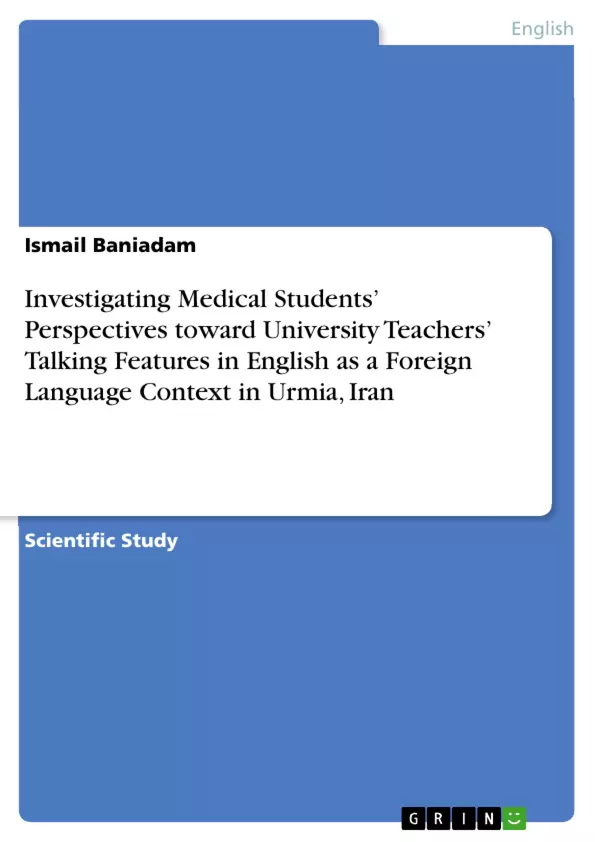This study aimed to investigate medical students’ attitudes toward some teachers’ talking features regarding their gender in Iranian context. To do so, 60 male and 60 female medical students of Urmia University of Medical Sciences (UMSU) participated in the research. A researcher made Likert-type questionnaire which was initially piloted was used to gather the data. Comparing the four different factors regarding the features of teacher talk, it was revealed that visual and extra-linguistic information factor, lexical and syntactic familiarity, speed of speech, and the use of Persian language had the highest to the lowest mean score, respectively. It was also indicated that female students rather than male students were significantly more in favor of speed of speech and lexical and syntactic familiarity.
Inhaltsverzeichnis (Table of Contents)
- I. INTRODUCTION
- II. LITERATURE REVIEW
- III. METHODOLOGY
- A. Participants
- B. Data Collection Instrument
- C. Data Analysis
- IV. RESULTS
- A. Descriptive Statistics
- B. Evaluating main factors in medical students' attitudes towards some features of teacher talk
- C. Evaluating Students' Attitudes Regarding Their Gender
- V. DISCUSSION
- A. Students Attitudes toward some Features of Teacher Talk
- B. Male vs. Female Medical Students' Attitudes toward Some Features of Teacher Talk
- VI. CONCLUSION
Zielsetzung und Themenschwerpunkte (Objectives and Key Themes)
This study aimed to investigate medical students' attitudes towards specific teacher talking features, particularly in relation to their gender, within the Iranian context. The research involved analyzing the perspectives of 60 male and 60 female medical students from Urmia University of Medical Sciences (UMSU) using a researcher-made Likert-type questionnaire.
- Factors influencing medical students' attitudes towards teacher talk features.
- Comparison of male and female students' attitudes towards teacher talk features.
- Impact of different teacher talk features on student comprehension and learning.
- Exploring the role of gender in shaping students' preferences for teacher talk styles.
- Understanding the significance of teacher talk in the EFL context, especially for medical students in Iran.
Zusammenfassung der Kapitel (Chapter Summaries)
The introduction lays the groundwork for the study by highlighting the importance of teacher talk in foreign language learning contexts, particularly for EFL learners. The study's objectives are outlined, focusing on the identification of factors influencing students' attitudes towards teacher talk and examining potential gender-based differences in these attitudes.
The literature review provides a comprehensive overview of previous research on teacher talk, drawing connections to related areas such as caretaker speech, foreigner talk, and the role of comprehensible input in second language acquisition. The review emphasizes the significance of teacher talk as a primary source of language exposure in EFL classrooms.
The methodology section details the research design, participant selection, data collection instrument, and data analysis procedures. The study employs a quantitative approach using a researcher-made questionnaire based on established frameworks, ensuring reliability and validity through piloting and statistical analysis.
The results section presents descriptive and inferential statistics that provide insights into medical students' attitudes towards teacher talk. The analysis reveals four main factors influencing these attitudes: speed of speech, lexical and syntactic familiarity, visual and extra-linguistic information, and the use of Persian language. Significant differences in attitudes between male and female students are observed, particularly in terms of preferences for speed of speech and lexical and syntactic familiarity.
The discussion chapter interprets the findings, comparing them with existing research on teacher talk and highlighting the implications for language teaching practices. The results suggest that teachers should be mindful of the factors influencing students' attitudes towards teacher talk, including gender-based differences, and adjust their communication styles accordingly to enhance comprehension and learning.
Schlüsselwörter (Keywords)
The study revolves around the concept of "teacher talk" in the EFL context, specifically investigating "attitudes" and "gender" as key factors influencing student perceptions. The research draws on the framework of "medical students" as a specific population group, focusing on "teacher talk features" such as "speed of speech," "lexical and syntactic familiarity," "visual and extra-linguistic information," and the "use of Persian language." The findings have implications for language teaching practices and highlight the importance of adapting teaching styles to enhance "comprehension" and "learning" for diverse student populations.
- Quote paper
- Ismail Baniadam (Author), 2018, Investigating Medical Students’ Perspectives toward University Teachers’ Talking Features in English as a Foreign Language Context in Urmia, Iran, Munich, GRIN Verlag, https://www.grin.com/document/444120



